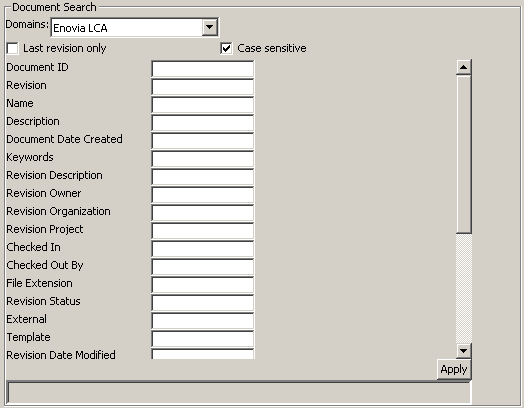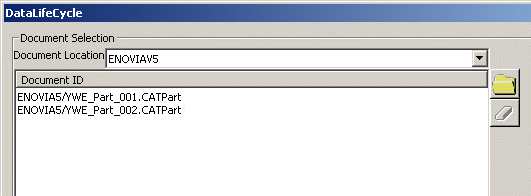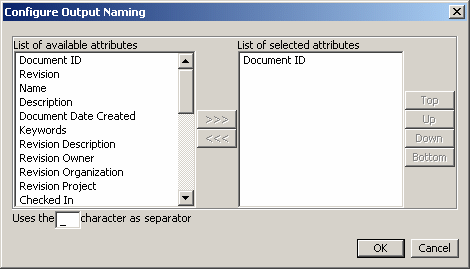-
In the Document Location list, select ENOVIA LCA.
-
Click
 to
open the Search Documents in ENOVIA LCA dialog box (click the
thumbnail below to see the full-size picture):
to
open the Search Documents in ENOVIA LCA dialog box (click the
thumbnail below to see the full-size picture): -
To connect to the ENOVIA LCA database, you need to indicate:
-
a user name
-
a password. The password is encrypted as you type it in the box and it is also encrypted in the XML parameter file if the standard CATIUExitCrypt interface is implemented
-
a database server (use the list to make your selection)
-
a port number
-
a role within the VPM user organization. You can either use the list to make your selection or enter directly the role. The role uses a specific syntax: Role.organization.Proj, for instance VPMDESIGNER.VPM.DEFAULT.
Refer to your ENOVIA LCA documentation for detailed information.
-
-
Click
 to
validate your options and connect to the database. This button is
available only when the necessary connection data have been entered.
to
validate your options and connect to the database. This button is
available only when the necessary connection data have been entered.If the connection is successfull, a pop-up message is displayed and prompts you to click OK (displayed in the pop-up message). The other boxes of the window are activated to let you enter the necessary data.
If the connection fails, a pop-up message is also displayed but this time, the message asks you to check that a server is running and that the user name and password you typed are valid.
More about the connection to the ENOVIA LCA database
- Exiting the batch interface ends your connection to the database
- The connection information (including the password) can be pre-valuated via the XML parameter file.
Document Search

Once the domain is selected, the list of attributes available for this domain is displayed. You can type one search criterion per attribute. All the conditions you specify are linked by an "AND" operator.
For more information on these attributes, refer to the Version 5 - Content Management User's Guide and to the Version 5 - LCA Document Management User's Guide on the ENOVIA LifeCycle Applications Documentation CD-ROM.
Note that if you are using a customized database, only one customized object is taken into account for the document search. For instance, if you have three document tables named "DOCUMENT1", "DOCUMENT2" and "DOCUMENT3", the search is run on one of these tables table only.
For more information, refer to "Using VPM Navigator on a Customized Database" in the Version 5 - VPM Navigator User's Guide on the ENOVIA LifeCycle Applications Documentation CD-ROM.You can use the following syntax to perform your search (below is an example of a search on the "Name" criterion):
-
IDselects documents named "ID" -
ID%selects documents whose name starts with "ID" -
%ID%selects documents whose name contains the string "ID".
If you want to retrieve only the last revision of the documents, select the Last revision only check box.
If you do not want the search to be case sensitive, clear the Case sensitive check box.
You can then click Apply to start the search: the progress bar at the bottom displays the search progress and when the search is over, a pop-up message indicates the number of valid documents found.
In case no document satisfying the search criteria is found, a a pop-up message is displayed. Otherwise, the list of selected documents (in the Document Selection area of the main application window) is updated and displays the name of the ENOVIA LCA documents fulfilling your search criteria:

If a document was already selected (in a previous query), it is removed from the search result since a document can appear only once in the list.
A pop-up message is displayed when selected documents are not locked or locked by another user.
Note that you can pre-valuate the selected documents directly in the XML parameter file. In that case, a test connection is set up and if the connection fails, the document selection aborts.
More about the document search
- You can run several queries. In that case, the list of valid documents is added to the list of the previous query in the main application window
- Only documents accessible to the end user are proposed, i.e. documents the end user can manage according to its role/ownership
- The Lock/Unlock attribute is not taken into account for the query
- The save in database is done only at the end of the batch process.
Output

This area indicates where the processed documents will be stored. By default, they are stored in the database. - Save documents in database
Lets you save your documents in the database. Only the locked documents will be saved in the database, unless you select the Force save operation on non-locked documents check box - Force save operation on non-locked documents
Lets you force the save of documents that are not locked in the database after the process - Save modified documents in the directory
Lets you save modified documents in the directory you specified in the Target Directory box of the Data Life Cycle window -
Definition of output naming
By default, this check box is cleared. If selected, it means that you can customize the name of output documents. This customization is defined in a specific dialog box that can be accessed by clicking Configure Output Naming...:

The list of all the attributes available for the domain you selected is displayed in the "List of available attributes". By default, the attribute "Document ID" is selected and is displayed in the "List of selected attributes".
In the "List of available attributes", select the desired attributes (you can select multiple elements using Ctrl or Shift) then click >>>. The selected attributes are transferred to the "List of selected attributes":

If needed, you can reorder the selected attributes. To do so, select the desired attributes (you can also use the multi-selection) then use the buttons displayed to the right:
- Top moves the selected attributes to the top of the list
- Up moves the selected attributes one line up in the list
- Down moves the selected attributes one line down in the list
- Bottom moves the selected attributes to the bottom of the list.
To transfer a selected attribute back to the "List of available attributes", select it then click <<<.
You can change the single character used as separator by default ("_") by entering a new one in the Uses the _ character as separator box.
Example
Let's suppose that the following attributes have been selected: Document ID, Name and Revision Organization.
Among the documents to be processed, one of them has the following values for the three selected attributes:- Document ID = 23010
- Name = Board
- Revision Organization = ADMIN
We leave "_" as separator.
This means that the HTML report generated in the target directory for this document is named as follows:
23010_Board_ADMIN.htmClick OK to validate and close the Configure Output Naming dialog box. -
When finished, click OK to validate.
![]()

